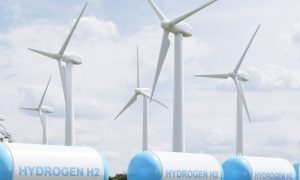Growth Plans: Uttar Pradesh’s renewable energy drive and future potential

Uttar Pradesh is ramping up its renewable energy efforts, with a current capacity of 8,816.1 MW, aiming for 43.3% by 2029-30. Key initiatives include the Uttar Pradesh Solar Energy Policy 2022, a focus on bioenergy, and green hydrogen production. Challenges persist in distribution inefficiencies and land acquisition, but policy support offers a positive outlook for future growth.
Uttar Pradesh is emerging as a key player in the renewables space and has been tapping different segments to meet its energy requirements. The total installed power capacity of the state stood at 31,622.83 MW, including 22,517.26 MW of thermal power, 289.48 MW of nuclear and 8,816.1 MW of renewable energy (including large hydro) as of July 2024. The state’s total renewable energy share (excluding large hydro) in the total power mix is currently 17 per cent, while the renewable purchase obligation (RPO) goal for the state for 2023-24 was 15 per cent. This target will be raised further in the coming years to meet the Ministry of Power’s national RPO objective of 43.3 per cent by 2029-30. Thus, the state needs to aggressively ramp up the share of renewables in its energy mix.
As Uttar Pradesh continues to struggle with rising energy demand, distribution inefficiencies and high grid tariffs, a shift towards renewable energy becomes even more crucial to meet its economic needs apart from environmental goals.
This article provides the current status of renewable energy in the state, recent policy developments and projects, challenges in the state’s power sector and issues faced by developers, and the way forward…
Solar energy
As of July 2024, Uttar Pradesh’s total installed solar capacity stood at 3,105.59 MW. The current capacity is low compared to the state’s target of achieving 22,000 MW of solar power projects by 2026-27. This target is further divided into 14,000 MW from utility-scale projects, 6,000 MW from rooftop solar (4,500 MW from residential installations and 1,500 MW from non-residential set-ups), and 2,000 MW from distributed generation. This means in order to meet this target, the state will have to add around 9 GW of solar capacity per annum, which seems challenging.
The state had announced the Uttar Pradesh Solar Energy Policy, 2022, which provides several incentives to meet these targets. To encourage the widespread adoption of rooftop solar, especially in the residential sector, the state offers attractive subsidies of Rs 15,000 per kW, up to a maximum of Rs 30,000 per consumer.
Aligning with the central government’s PM-KUSUM scheme, the policy offers substantial additional subsidies for solar irrigation. Under Component C1 of the scheme, which deals with the solarisation of grid-connected pumps, the scheduled tribes as well as Vantangia and Musahar caste farmers can avail of an additional 70 per cent subsidy, while other farmers are eligible for a 60 per cent subsidy, over and above the central subsidies. For Component C2, which focuses on the solarisation of agricultural feeders, the state provides viability gap funding of up to Rs 5 million per MW. In addition, the policy encourages utility-scale solar systems with four-hour battery storage capabilities, offering a substantial subsidy of Rs 25 million per MW for such projects to address intermittency issues associated with solar power. In the decentralised space, the state government also aims to power all 1,994 cold storages, collectively holding 16.5 million metric tonnes of storage capacity, with solar energy.
To facilitate the evacuation of solar projects, the state is setting up a green energy corridor in the Bundelkhand region. This infrastructure is initially designed to handle 4,000 MW of solar capacity, with the potential for capacity enhancement depending on private investment, ensuring that the state’s transmission infrastructure keeps pace with its ambitious solar generation targets. This is crucial, since the Bundelkhand region is expected to witness solar uptake going forward. In March 2024, Bundelkhand Solar Energy Limited announced the development of a 1,200 MW solar power project in Jalaun district, making prior evacuation planning with green energy corridors a step in the right direction.
Recognising the challenges of land availability, Uttar Pradesh is actively exploring floating solar photovoltaic (FPV) projects. A detailed assessment titled “Solar Revolution on Water: Evaluating the Potential of Floating Photovoltaic Systems in Uttar Pradesh” by the Uttar Pradesh New and Renewable Energy Development Agency (UPNEDA) has revealed promising opportunities, identifying 4,128 waterbodies above 15,000 sq. m, of which 2,192 are perennial. These perennial waterbodies offer a cumulative surface area of 468.11 million sq. m, presenting a substantial opportunity for FPV installations.
Considering a conservative coverage of 20-30 per cent of these waterbodies, the potential FPV capacity ranges from 9.54 GW to 14.32 GW. This translates to a projected annual energy generation of 13-20 TWh.
The state has already taken concrete steps in FPV implementation. A 20 MW capacity project is operational at the Auraiya Dam, and a larger 150 MW grid-connected floating solar PV plant is under construction at the Rihand Reservoir the Sonbhadra district. The state government plans to build a 50 MW floating solar power plant at the Bhakhira Bird Sanctuary in eastern Uttar Pradesh.
Bioenergy
Uttar Pradesh is harnessing its agricultural resources and waste streams to develop the bioenergy sector as well. The state launched its Bioenergy Policy, 2022, with ambitious targets across various bioenergy segments. The policy aims to install compressed biogas (CBG) plants with a total capacity of 1,000 tonnes per day (tpd), establish biocoal plants with a cumulative capacity of 4,000 tpd, and set up bioethanol and biodiesel plants with a combined capacity of 2,000 kilolitres (kl) per day.
To achieve these goals, the state has introduced a range of incentives. For CBG projects, the policy offers financial support of up to Rs 200 million, calculated at Rs 7.5 million per tonne of capacity. Similar incentives are provided for biocoal and biodiesel projects, with subsidies calculated based on production capacity. Beyond direct financial incentives, the bioenergy policy includes subsidies for equipment procurement, with the state offering a 30 per cent subsidy (up to Rs 2 million) on the cost of balers, rackers and trawlers. The policy also provides a 100 per cent exemption in electricity duty for bioenergy enterprises for 10 years from the date of commercial operation, substantially reducing operational costs and improving long-term project viability.
As of July 31, 2024, the total installed biopower capacity of the state stood at 2,237.39 MW. Going forward, as of the latest data, 152 bioenergy projects have received in-principle approval, with 32 projects securing approval from the state-level committee. These approved projects represent a total estimated investment of Rs 54.49 billion. Breaking this down by sector, 102 CBG plants with a combined capacity of 847 tpd (84.7 per cent of the 2027 target) have been approved. In the biocoal sector, 24 plants with a capacity of 1,324 tpd (33 per cent of the target) have been approved. For biodiesel, 26 plants with a capacity of 1,119 kl per day (56 per cent of the 2027 goal) have received approval.
Hydro and pumped storage
As of July 31, 2024, the total installed capacity of small hydro and large hydro in Uttar Pradesh stood at 49.1 MW and 3,424.02 MW respectively. The state is focusing on pumped storage projects to ensure grid stability and provide back-up during power outages.
A study titled “Preliminary Assessment for Pumped Storage Potential in Uttar Pradesh” by UPNEDA has identified 33 potential locations for pumped storage facilities across the state, with a combined energy storage potential ranging from 186.96 GWh to 200.42 GWh. The study considers two topologies for PSP implementation. The first involves linking existing reservoirs via penstocks and adding powerhouses to transform them into pumped storage facilities. This approach offers an energy storage potential from 96.45-109.91 GWh. The second topology focuses on identifying suitable locations for constructing a second reservoir alongside an existing lake or reservoir, presenting an additional 90.51 GWh of storage potential. The majority of identified locations are concentrated in the Chandauli, Mirzapur and Sonbhadra regions.
Various projects are in the planning stage. The Uttar Pradesh government granted in-principle approval for THDC India Limited’s 1,200 MW PSP in the Robertsganj tehsil of Sonbhadra district. The Greenko Group also has plans to set up an off-stream closed-loop pumped storage project in Sonbhadra to generate 3,660 MW of electricity at an investment of Rs 170 billion. Meanwhile, ACME Cleantech Solutions will develop two off-stream closed-loop pumped projects in Prayagraj and Meerganj.
Green hydrogen
Recognising the transformative potential of green hydrogen, Uttar Pradesh recently approved its green hydrogen policy and a proposal for setting up two 800 MW units in Anpara in collaboration with NTPC Limited. The policy has an ambitious target of achieving an annual production of 1 million metric tonnes of green hydrogen by 2029. The current hydrogen demand in the state is approximately 0.9 million metric tonnes per annum, which is mainly used in the fertiliser and refinery sectors.
To kickstart the green hydrogen economy, the state government has implemented a range of incentives and subsidies totalling Rs 50.45 billion for businesses planning to establish operations within the next five years. These incentives include capital expenditure subsidies ranging from 10 to 40 per cent for the initial five industries, as well as full rebates on intra-state electricity charges and exemptions on transmission charges for interstate transactions. Additionally, the policy provides a complete exemption from electricity duty to further support industry expansion.
The state’s green hydrogen policy also focuses on research and development to drive down production costs and advance new technologies. Two centres of excellence will be established to spearhead these efforts. In addition, the policy encourages the development of carbon dioxide recovery units to utilise carbon emitted from biogas and other industries, promoting a circular economy. Moreover, the state will provide support in assessing the right of way from production units to consumption centres for green hydrogen, ammonia and their derivatives, facilitating the development of storage and transportation technologies.
Challenges and the way forward
While the push towards promoting different renewable energy segments is impressive, the broader level challenges related to the state’s distribution inefficiencies, high grid tariffs and frequent power outages still exist and need to be resolved. To the state’s credit, several of these inefficiencies have seen an improvement. For instance, the overall average aggregate technical and commercial losses of Uttar Pradesh’s five discoms were 22.33 per cent during 2022-23. While this number is still high, it is a reduction from the 31.02 per cent during 2021-22. In addition, the overall annual collection efficiency of the state’s discoms stood at 93.18 per cent during 2022-23, increasing from 85.91 per cent from the previous year. To further improve collection efficiency, the uptake of smart metering is key. While 30,978,280 smart meters have been sanctioned in Uttar Pradesh, the state has only installed 1,186,953 as of August 20, 2024, according to the National Smart Grid Mission. Still, the installed number is the highest among all states. Over the years, the state has focused on several innovative technologies to improve efficiencies. For instance, it was one of the first states to explore blockchain technology for peer-to-peer trading of rooftop solar systems, in a bid to enhance transparency and efficiency in power trading and distribution.
In fact, the issue of elevated grid tariffs for commercial and industrial consumers (C&I) is turning into a blessing in disguise as this is pushing these consumers to set up rooftop solar projects or purchase power through the open access route as a more cost-effective alternative. For instance, recently, in July 2024, UPNEDA auctioned 500 MW of rooftop solar projects to be set up across government buildings and other institutions – with the lowest tariffs reaching Rs 4.85 per kWh and Rs 4.90 per kWh for different categories. In addition, renewable energy open access project development has been active in the state. Recently, in May 2024, Amplus commissioned a 73.4 MWp intra-state open-access solar plant in Jhansi, Uttar Pradesh – the company’s third solar open access plant in in the state, following the development of projects in Mirza and Deoria. In addition, in June 2024, SunSource Energy also commissioned three open access solar power facilities in the state with a combined capacity of 45 MWp. Going forward, the formulation of green energy open access rules in the state will facilitate easier access to renewable power for small-scale C&I consumers, bringing in a significant boom in the state’s renewable open access market.
However, setting up renewable energy projects comes with its own challenges. Renewable energy developers face several challenges including land acquisition issues, inadequate transmission infrastructure and regulatory uncertainties. High dues of discoms to generators is another key issue. According to the PRAAPTI Portal, the current dues of the state’s discoms to gencos for September 2024 are Rs 73.09 billion, a relatively high number.
Net, net, the policy impetus and the renewable project pipeline in the state make the future outlook positive. However, success will depend on addressing challenges related to inefficiencies in the distribution sector, land acquisition, grid infrastructure and regulatory clarity, especially with respect to open access. The state has worked on these fronts but much more needs to be done to fully harness its renewable energy potential.
By Preeti Wadhwa
Source Link : https://renewablewatch.in/2024/09/25/growth-plans-uttar-pradeshs-renewable-energy-drive-and-future-potential/
















